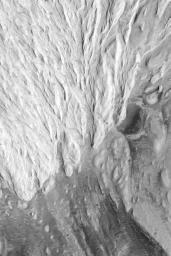
|
Sediment History Preserved in Gale Crater Central Mound
- Click the image above for a larger view
- Full-Res JPEG (780 x 1173) (139.1 kB)
- Full-Res TIFF (780 x 1173) (874.7 kB)
Caption:
This image continues the theme of things eroded, things covered up, and then exposed again. The circular feature labeled, "Partly-Exhumed Crater," is interpreted to be an ancient impact crater that formed on the same layered rock surface into which the channel in PIA02844 was cut. This crater, like the channel in PIA02844 , indicates that the layered rock was exposed to the atmosphere for some period of time before the next layer of material--the bright, almost white ridged rock that covers most of the upper half of this picture--was deposited. In this scenario, the sedimentation ceased long enough for the lower rocks seen here to remain exposed, so that meteorites could hit the surface and form craters. These craters were then buried by the bright material that still covers about 1/3 of the partly-exhumed crater in this scene. When an ancient erosion surface, such as that into which the crater formed, is buried by additional layers of material, a gap in the geologic record is created. Geologists call a gap such as this an erosional unconformity.
Note: This is a subframe of PIA02843
Cataloging Keywords:
| Name | Value | Additional Values |
|---|---|---|
| Target | Mars | |
| System | ||
| Target Type | Planet | |
| Mission | Mars Global Surveyor (MGS) | |
| Instrument Host | Mars Global Surveyor | |
| Host Type | Orbiter | |
| Instrument | Mars Orbiter Camera (MOC) | |
| Detector | ||
| Extra Keywords | Atmosphere, Crater, Grayscale, Impact | |
| Acquisition Date | ||
| Release Date | 2000-12-05 | |
| Date in Caption | ||
| Image Credit | NASA/JPL/MSSS | |
| Source | photojournal.jpl.nasa.gov/catalog/PIA02845 | |
| Identifier | PIA02845 | |
